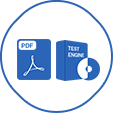Last Update 9 hours ago Total Questions : 735
The Essentials of Internal Auditing content is now fully updated, with all current exam questions added 9 hours ago. Deciding to include IIA-CIA-Part1 practice exam questions in your study plan goes far beyond basic test preparation.
You'll find that our IIA-CIA-Part1 exam questions frequently feature detailed scenarios and practical problem-solving exercises that directly mirror industry challenges. Engaging with these IIA-CIA-Part1 sample sets allows you to effectively manage your time and pace yourself, giving you the ability to finish any Essentials of Internal Auditing practice test comfortably within the allotted time.
During an audit engagement, a junior staff internal auditor begins to suspect a fraud may have occurred involving a friend of the engagement supervisor. He reports his concerns to the engagement supervisor, who disagrees with his suspicions and directs him to continue with the engagement as planned. Given the circumstance, what is the most appropriate action for the junior auditor to take?
Which of the following is an indicator that the organization s risk management process is effective?
An automobile manufacturer will become one of the first in the industry to adopt a new inventory management software. Despite the system being new to the market, senior management believes that the benefits are great enough to offset the potential risks. Which of the following aspects of risk management does senior management’s decision best illustrate?
According to MA guidance, which of the following is an appropriate role for the internal audit activity?
An internal auditor assessed that the risk of steel theft at a plant is high. In response, the plant's management introduced a number of controls, including fences around the facility, a metal detector at the entrance, and monthly steel inventory counts. If the controls operate as intended, which of the following outcomes would the internal auditor hope to see?
According to MA guidance, which of the following statements is true regarding internal auditors' use of technology-based techniques?
The collaborating style for conflict resolution, where the parties promote assertiveness and work together to develop a mutually beneficial solution, is best used in which of the following situations?
The internal audit activity is asked to review the effectiveness of controls around the disposal of chemical waste. However, the internal auditors on staff lack the necessary skills to conduct this review. Which of the following would be the most appropriate approach?
During fieldwork, an internal auditor located a significant internal control issue. Without identifying the origins of the issue, the auditor concluded the engagement and included the issue in the final audit report. To enhance audit quality, which of the following skills should the internal auditor improve?
The management at a national consumer goods organization implements a fair work and pay practice as well as a policy to treat employees equitably and consistently.
Which common characteristics of fraud will the practice and policy most likely reduce?
The results of an assessment of the adequacy of controls would be considered incomplete or misleading unless the internal auditor considers which of the following?
A whistle blower notified internal audit of a conflict of interest between an organization's employee and a major supplier. Which of the following steps should be undertaken first?

